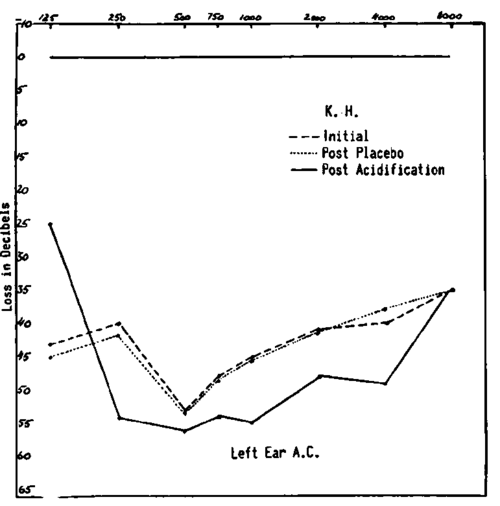Acid And Alkaline Symptoms. Impaired Hearing
Description
This section is from the book "Research In Physiopathology As Basis Of Guided Chemotherapy With Special Application To Cancer", by Emanuel Revici. Also available from amazon: Research In Physiopathology
Acid And Alkaline Symptoms. Impaired Hearing
In studying the various otological problems, B. Welt and I noted that many patients with impaired hearing experienced variations in auditive acuity at different times of the day, or even in conjunction with food intake. This led us to investigate impaired hearing by the same method used for pain. (Fig. 27) We studied the influence of acidifying and alkalizing agents upon auditive acuity in cases of impaired hearing.
Complete audiograms were obtained, employing differences of only two decibels between measurements and using all of the accepted frequencies for air and bone conduction. Audiograms were obtained in subjects before and after administration of acidifying agents, such as ammonium chloride and ammonium monophosphate, and alkalizing agents such as sodium bicarbonate. In normal subjects, the audiograms showed little or no change. In subjects with impaired hearing, three types of responses were noted for any one agent. The audiogram was either not changed at all or an increase or decrease in acuity was seen. If a manifest increase in acuity was obtained with one group of agents, an opposite effect was obtained when an agent of the opposite group was administered.

Fig. 31. The administration of 2 grams of monoammonium phosphate induces a decrease in hearing acuity if the abnormal pattern is acid.


Fig. 32. Acid pattern of hearing impairment.
Changes of at least 6 decibels were required before they were considered to be induced by an agent. When changes of such intensity were obtained with an agent, it was invariably true that opposite changes would be obtained with an opposite agent. It was also true that the same responses could be obtained in the same patient in repeated tests. This appears to be highly significant, indicating that the response was, in fact, correlated with changes induced by the administered agent, changes similar to those seen in the case of acid base symptoms. It was thus possible to integrate hearing impairment in the group of acid base symptoms and to recognize two well defined types, one corresponding to an acid pattern, the other to an alkaline. Figures 28 through 32 illustrate several cases taken from Welt's observation. It must be noted that changes under the influence of the agents are seen at almost all frequencies in some cases but at only certain frequencies in others.
It must be noted also that not all cases of impaired hearing could be placed in one or the other category. While this could be done almost without exception for young subjects or for those with still evolving conditions, it could not be done for subjects with old, fully evoluted impairment. It appears that once the pathological processes have arrived at a terminal point—and an inactive sclerotic scar is present—a response to acidifying or alkalizing agents is no longer to be expected.
Continue to:


